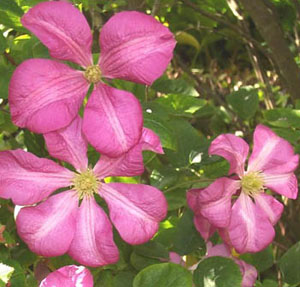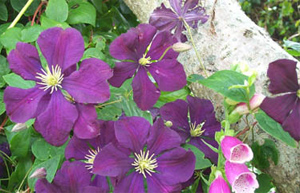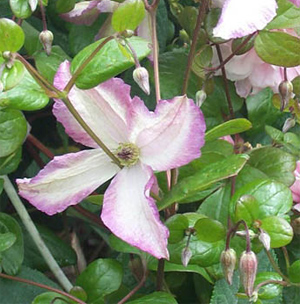 C. "Margot Koster"
C. "Margot Koster"
A Shallow Grave - Growing Clematis in Cornwall
by
Charlie Pridham
Charlie Pridham runs a small nursery with his wife Liz, specialising in Climbing and Conservatory plants, at Roseland House, in the village of Chacewater, near Truro. As well as running the nursery they maintain one of the NCCPG's National collections of Clematis viticella cultivars and open their one acre garden to the public on Tuesday and Wednesday afternoons from April to September. Formally a merchant navy officer, Charlie left the sea 20 years ago and the nursery is now a full time occupation. Pride is taken in propagating all the plants the nursery sells, which by definition focuses on those plants which do well in Cornwall as all the stock plants are to be found growing at the garden.
Down here in the west of Cornwall we grow our Clematis with only four inches of top soil, high winds and slugs the size of pythons. It often seems more appropriate to be reading books on survival at sea rather than gardening books, which with few exceptions seem to be written by folk with no idea what wind can do. I find when Cornish gardeners talk of a "windy garden" they really mean it! So, with exposure from wind, lack of soil, and despite the high annual rainfall (48"), this is a very dry garden (the soil must be free draining or we would be living in a swamp!) A week without rain in summer seems like a drought. All conspire to make gardening a challenge.
It is true that in the case of clematis, that it is going to be difficult to achieve the sort of display that can be seen in perfect growing conditions, but it is more than possible to achieve fantastic results with little effort as long as you bear in mind a few basic requirements.
 C. "Etoile Violette"
C. "Etoile Violette"
I always give newly planted Clematis a watering tube into the planting hole. They are thirsty plants and I feel they benefit from receiving their water at the roots and below, so that they will be encouraged to go downwards for moisture, the underlying rock here being quite soft. A washing up liquid container or milk bottle with top and bottom cut off makes a good tube, and will last the two or three years needed to establish plants in these far from ideal conditions. Plant deeply with the original pot soil level going 3-6" down. I often increase the soil depth by building raised beds or plant at an angle, but burying dormant buds near the base of the plant will pay dividends in years to come. Try and remember to water down the tube once a week regardless of weather the first summer, after that they are left to take their chances. Clematis need access to moisture at all times and although they will over time develop a large root system they are very vulnerable to drying out when newly planted.
A heavy organic mulch is applied each year to enrich the soil (rather than the oft quoted placing of stones - no point providing B&B for the slugs and snails!) conserve moisture, and combat the high levels of arsenic and other toxic minerals present in our sub soil. The whole mining area of Cornwall suffers to varying degrees with this problem, as we discovered shortly after moving in. We dug a pond and then found out nothing would grow in the spoil removed (not even weeds). We eventually noticed that where the grass cuttings were spread straight on the bare ground weeds were appearing, so that was the last time we did any digging (you try and come up with a better excuse!). The organic material seems to bind the arsenic and enable plants to grow. I also use "Blood Fish and Bone" as a feed in the spring.
 C. "Chacewater"
C. "Chacewater"
Although we have over one hundred-plus Clematis in the garden, only a very few of the large flowered hybrids such as 'Nelly Moser' perform well, and over the years our attention has focused on the species and their forms, as well as the stronger growing and late flowering cultivars; I see the words "Compact and free flowering" and know that for me the plant will grow to only 18" and cover itself in flowers, wonderful in a pot but in the garden as a climber, perfectly useless. I now nearly always chose from those Clematis in the "Hard Prune" group and if the information is available the ones with a large element of Clematis viticella in their make up, these seem to do especially well. So choice of Clematis types is very important and remember that garden centres offer good plants, but they will be the same choice across the country so itís up to you to reject as unsuitable those that won't perform well in the Duchy.
You cannot write about any sort of gardening in Cornwall without mentioning the wind. We live just a mile from one of several wind farms in Cornwall, wind speeds of 80 mph plus are so common as to not be newsworthy. The benefits of growing a plant that you can cut down in the winter when the worst storms occur will be obvious. We find growing Clematis into host plants gives us much better protection from wind than walls. Trellises need wires criss-crossing the gaps to give a better grip. And grip they will, the viticella types hanging on like an Octopus with vertigo! If you do want to grow your clematis on a wall remember it will act like sand paper on a windy day so give the clematis an air gap of at least 3" between the trellis or wire netting and the wall, and never grow clematis on single strands of wire.
 C. caerulea "luxurians"
C. caerulea "luxurians"
So is it worth the effort? Well, many Clematis types do well here, some, like the yellow C. "Bill Mackenzie", rather too well! Even those struggling a little, still do a better job than any other climber I can think of, and in a county famous for its spring flowering shrubs, having a plant that will grow over and through them and be smothered in flowers for three months in Summer is the horticultural equivalent of having your cake and eating it!. We just wish more breeders would come up with plants with a bit of get up and go! For that reason, we decided to breed some of own! But that is another story.
© 2005 Charlie Pridham
